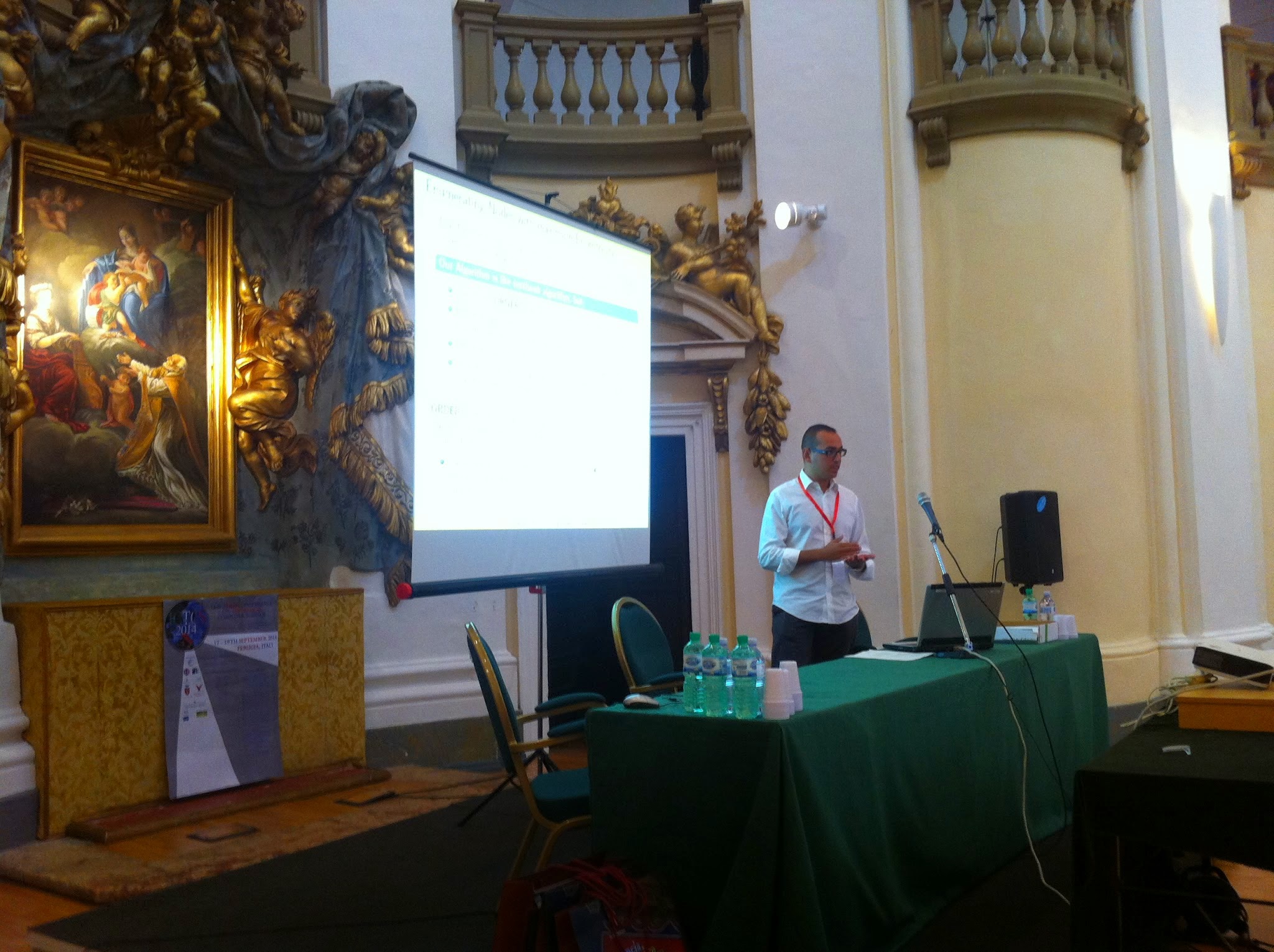Birth: June 1985
Position:
- Associate Professor at Dipartimento Statistica, Informatica, Applicazioni at University of Florence. Since February 2022
-
Since April 2021 (until April 2030) qualified for Full Professorship in Computer Science in Italy (in Italian, Abilitazione Scientifica Nazionale di Prima Fascia)
Past Position:
- Assistant Professor (Ricercatore a Tempo Determinato B) at University of Florence. February 2019 — January 2022
- Assistant Professor (Ricercatore a Tempo Determinato A) at University of Pisa. February 2016 — January 2019
- Research Fellow at University of Pisa. March 2015 — January 2016
- Research Fellow at University of Milan, hosted by LAW, Laboratory for Web Algorithmics. March 2013 — February 2015.
Training:
- PhD degree in Computer Science at University of Florence, advised by Prof. Pierluigi Crescenzi (From January 2010 to December 2012). Subject: Algorithms for Biological Graphs: Analysis and Enumeration. PhD defence: April 29th 2013.
- Master’s Degree cum Laude in Computer Science at University of Florence; 1 A.Year instead of the 2 expected (A.Year 2007-2008). Graduation Date: April 29th 2009.
- Bachelor’s Degree cum Laude in Computer Science at University of Florence; 3 A.Years as expected (From A.Year 2004-2005 to A.Year 2006-2007). Graduation Date: September 28th 2007.
Award:
- Best Italian Young Researcher in “Theoretical Computer Science” 2022.
Italian Chapter of the EATCS (European Association for Theoretical Computer Science). - Best Italian PhD Thesis on “Algorithms, Automata, Complexity and Game Theory” 2013.
Italian Chapter of the EATCS (European Association for Theoretical Computer Science).
Research Interest
In a society in which we are almost always “connected”, the capability of acquiring different information has become a source of huge amounts of data to be elaborated and analysed. Graphs are data structures that allow to model the relationships in these data, abstracting from specific and particular aspects and representing effectively millions or billions of connections: the complexity of the involved entities is enclosed in the vertices of the graphs and the complex mechanisms of interaction among them are described by an arc. For example, a social network can be seen as a graph whose nodes are the users and whose edges correspond to the friendships among them. Analogously, the economy of Bitcoin (or of any other economic system) corresponds to a graph whose nodes are the users and whose arcs correspond to payments among them. In such a context, discovering the most important or influent users, which ones will be their future friendships, which communities they belong to, and which is the structure of their society can be translated into problems on graphs. The research in this field focuses on developing models and algorithms to solve this kind of problems in efficient way on real-world graphs of large size. In particular, the research moves along two orthogonal axes: the former is devoted to the translation of a real-world problem in terms of a problem on graphs; the latter is aimed to develop efficient algorithms to solve the graph problem, possibly with (quasi-)linear time complexity. In this sense, theory and practice proceed together, as practical problems motivate contributions to theoretical computer science, which in turn allow efficient, useful, and practical solutions to the original problems.
Activities and Highlights
Author of a book, conference papers, and journal papers on graph algorithms with applications to enumeration, web crawling, bioinformatics, real-world graph analysis, information retrieval, mobile ad hoc networks, and computational linguistic. Check out google scholar to know my h-index or number of citations.
- Enumeration Algorithms: Author of a book (published by Atlantis Press, 2015) and other publications in this field. Co-author of the current best algorithm to list all the paths and cycles in a graph (SODA 2013), improving Johnson Algorithm (1975). Co-author of the current best output-sensitive algorithm to list all the maximal cliques in a graph (ICALP 2016). Coauthor of other several state of the art algorithms for listing basic structures of graphs and coauthor of general frameworks (MFCS 2018 and SIDMA 2019).
- Algorithms for Real-World Graph Analysis: Co-author of state of the art algorithms to compute: diameter, hyperbolicity, and top-central nodes (closeness centrality) in huge graphs. The diameter algorithm (TCS 2013) has been used to compute the diameter of Facebook networks (1.2 billions of nodes) by Backstrom, Boldi, Rosa, Ugander, and Vigna in “Four degrees of separation” (WebSci 2012) (reported by The New York Times, (325):B1, 21 November 2011). More recently, interested in algorithms for temporal graph analysis extending notions and algorithms of classical graph theory to temporal graphs.
- Temporal Graphs: Several publications revisiting fundamental notions of static graph theory for temporal graphs, including Menger’s Theorem, Edmond’s Theorem, Eulerian paths and walks, temporal diameter, temporal closeness, temporal neighboorhood function, temporal coloring.
- Bitcoin Graph Analysis. In a Bitcoin network, the nodes are user addresses and each edge represents a transaction from a payer address to a recipient one. Understanding Bitcoin economy and dynamics often translate in measuring properties of these networks. In this context, we have measured how the concentration of richness change over time, showing that “Rich get richer and poor get poorer” and the presence of artificial patterns.
- Web Crawling: One of the BUbiNG developers; BUbiNG is the publicly available web crawler currently with the highest performances (downloading, storing, and managing billions of web pages), developed at LAW (Laboratory of Web Algorithmic), University of Milan.
- Bioinformatic: Collaborator of INRIA (Institut National de Recherche en Informatique et en Automatique) BAMBOO & BAOBAB Team,Université Claude Bernard (Lyon 1), headed by Marie-France Sagot, working on metabolic networks and NGS (New Generation Sequence), designing ad hoc enumeration algorithms.
Teaching
- Since 2020 Teacher of Algorithms and Programming for Data Analysis (master in Statistics) at University of Florence.
- Since 2019 Teacher of Basics of Computer Science for the degree in Statistics (second year) at University of Florence.
- Since 2019 Teacher of Advanced Algorithms and Graph Mining (master) at University of Florence.
- Teacher of Basics of Computer Science for the degree in Physics (first year) at University of Pisa, a.a. 2018-2019 (36 hours).
- Teacher of Basics of Computer Science for the degree in Physics (first year) atUniversity of Pisa, a.a. 2017-2018 (72 hours).
- Teacher for Laboratory of Algorithms (Algorithms and C programming language) for the degree in Computer Science (first year) at University of Pisa, a.a. 2016-2017 (48 hours).
- Teacher of Basics of Computer Science and Programming (JavaScript programming language) for the degree in Informatica Umanistica (first year), at University of Pisa, a.a. 2016-2017 (28 hours).
- Teacher for Laboratory of Algorithms (Algorithms and C programming language) for the degree in Computer Science (first year) at University of Pisa, a.a. 2015-2016 (30 hours).
- Teacher for Laboratory of Algorithms (algorithms and Python) for the degree in Informatica Umanistica (first year), at University of Pisa, a.a. 2015-2016 (22 ore).
PhD
- Since 2019, member of the faculty board of the PhD (in italian, Collegio di dottorato) on Mathematics, Computer Science, Statistics shared by University of Florence, Siena, and Perugia.
- Teaching Phd Course on Python (Computer Science Basics for Data Scientist), March 2020 at University of Florence.
- Teaching Phd Course on Graph Mining Algorithms, February 2018 at University of Pisa.
- Teaching Phd Course on Algorithms For Big Data (part 2), March 2015 at University of Pisa.
- Co-supervision of Damiano di Francesco Maesa (topic ”Blockchain Applications: Bitcoin and Beyond”, XXX year, Università di Pisa)
- Co-supervision of Shima Moghtasedi (topic ”Algorithms for timed walks”, XXXII year, Università di Pisa)
Research Activity within Other International Institutes
- Research Activity within Centro de Ciências Departamento de Matemática of the Universidade Federal do Ceará (UFC), Fortaleza, Brasil (Prof. Ana Silva): 24 Novembre – 15 Dicembre, 2019.
- Invited Researcher at Takeaki Uno lab at National Institute of Informatics of Tokyo:
- 1 October 2019 –2 November 2019 (33 days).
- 19 June – 9 July, 2019 (21 days).
- 23 November – 16 December, 2018 (23 days).
- 19 September – 15 October, 2018 (26 days).
- 5–21 October, 2017 (16 days).
- 27 May–10 June, 2017 (15 days).
- Frequent visitor at IRIF, Université Paris Diderot (Prof. Pierluigi Crescenzi) and previously at Laboratoire d’Informatique Algorithmique: Fondements et Applications (LIAFA), Prof. Michel Habib, University of Paris Diderot (Paris 7, 19–23 marzo, 2012).
- Researcher invited by BAMBOO & BAOBAB Team at BAMBOO & BAOBAB Team, INRIA Grenoble Rhône-Alpes, Laboratoire de Biométrie et Biologie Évolutive (LBBE), and Université Claude Bernard (Lyon 1):
- 15 January – 18 March, 24 March – 18 May 2012 (4 months),
- Other periods as invited researcher (for a total of 43 days): 22 January – 5 February 2011, 26 April – 7 May 2011, 10–17 September 2011, 25–30 October 2011, 16–20 December 2012.
- Visiting, together with INRIA BAMBOO Team, University of São Paulo (USP) and Laboratório Nacional de Computação Científica (LNCC), Petrópolis, Brasil, March 31 – April 16, 2012.
- Visiting, together with INRIA BAMBOO Team, KDBIO Group at INESC-ID, Instituto Superior Técnico, Lisbon. February 15– 21, 2012.
- Visiting, together with INRIA BAMBOO Team, hosted by Leen Stougie, at Centrum Wiskunde & Informatica (CWI), Amsterdam, March 5– 9, 2012; July 4– 10, 2011.
Editorial Boards
- Guest Editor for Discrete Applied Mathematics for the Special Issue WEPA 2018
- Guest Editor for Algorithms for the Special Issue Algorithmic Aspects of Networks, 2019-2020
Program Committees
- WSDM 2023
- STACS 2023
- LATIN 2022
- ESA (Track B) 2021
- ICTCS 2021
- ALENEX 2020
- IWOCA 2020
- IEEE ISCC 2020
- WWW 2018, 2019, 2020, 2021, 2022
- COMPLEX NETWORKS 2017, 2018, 2019, 2020, 2021, 2022
- SEA 2018
- WEPA 2018 (PC-chair), 2019
- SAC SONAMA 2018, 2019, 2020, 2021, 2022
- IIR 2017, 8th Italian Information Retrieval Workshop.
- GOODTECHS 2016, 2017,
- LSDVE (Euro-Par workshop) 2017.
Book:
- Analysis and Enumeration: Algorithms for Biological Graphs. Atlantis Press 2015.
Publications: see http://www.andreamarino.it/?page_id=24
Notes:
- Professional Engineering Qualification (Information engineering).

